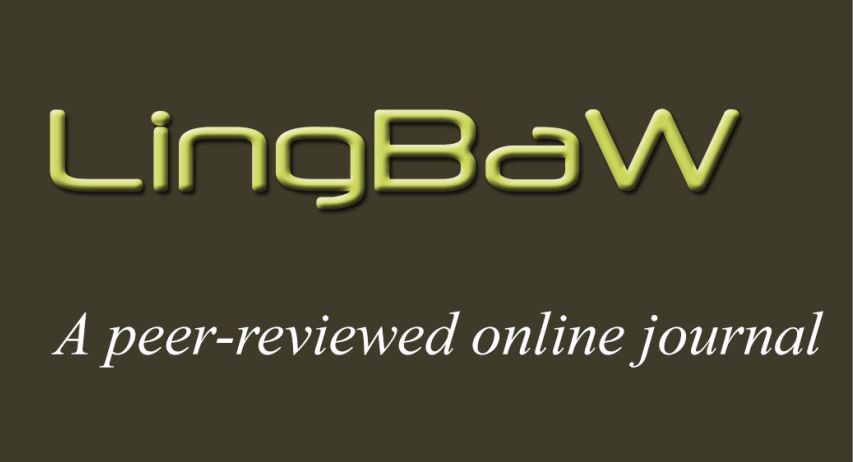“A glass half full” or “a breastless dwarf”: Metaphorical talk in women’s accounts of Turner syndrome
Abstract
This paper examines body-related metaphors used by Polish women to describe lived experiences associated with Turner syndrome (TS), and highlights the contribution this form of analysis can make to the study of health, emotional well-being, and social identity. Turner syndrome is a genetic aberration that affects females, and results in short stature, ovarian failure and a number of less typical body deformations; it often takes a long time to be appropriately diagnosed. Metaphor analysis is employed to analyze a data subset of four semi structured interviews audio recorded and translated from Polish into English. The analysis is carried out with metaphor operationalized as a framing device in discourse, whose main function is to impose a particular axiologically-charged construal of TS. Metaphorical concepts lying at the basis of the metaphors used were identified and grouped into four themes: (i) diagnosis and therapy; (ii) Turner syndrome (iii) appearance (iv) self-esteem and social positioning. The results of the analysis show that a range of composite metaphors develop on the basis of the BODY IS A PHYSICAL OBJECT as a primary metaphor but their occurrence depends on the salience of particular bodily symptoms of TS in individual women. Results are discussed with regard to the function and the utility of metaphor analysis in health, emotional well-being, and social identity research.
Keywords:
body, conceptual metaphor, discourse, Turner syndromeReferences
Afifi, T. D., L. Olson, and C. Armstrong. 2005. The chilling effect and family secrets: Examining the role of self protection, other protection, and communication efficacy. Human Communication Research 31: 564–598. (Crossref)
Bamberg, M. 2011. Who am I? Narration and its contribution to self and identity. Theory & Psychology 21(1): 3–24. https://doi.org/10.1177/0959354309355852 (Crossref)
Bergen, B. K. 2012. Louder than words: The new science of how the mind makes meaning. New York: Basic Books.
Cragg, S., J. and K. D. Lafreniere. 2010. Effects of Turner syndrome on women’s self-esteem and body image. Journal of Developmental and Physical Disabilities 22: 433–445. https://doi.org/10.1007/s10882-009-9178-0 (Crossref)
Crawford, L. E., S. M. Margolies, J. T. Drake, and M. E. Murphy. 2006. Affect biases memory of location: Evidence for the spatial representation of affect. Cognition and Emotion 20: 1153–1169. https://doi.org/10.1080/02699930500347794 (Crossref)
Crenshaw, M. L., and C. Bondy. 2019. Turner syndrome. NORD. Rare disease database. https://rarediseases.org/rare-diseases/turner-syndrome/
Crompvoets, S. 2006. Comfort, control, or conformity: Women who choose breast reconstruction following mastectomy. Health Care for Women International 27(1): 75–93. (Crossref)
Demjén, Z., and E. Semino. 2017. Introduction. Metaphor and language. In Z. Demjén, and E. Semino (eds.), The Routledge Handbook of Metaphor and Language, 1–10. Taylor and Francis. (Crossref)
GARD (Genetic and Rare Diseases Information Center). 2016. Rare diseases. Turner syndrome. https://rarediseases.info.nih.gov/diseases/7831/turner-syndrome/cases/54768#ref_10384
Gibbs, R. W., Jr. 2006a. Embodiment in cognitive science. New York: Cambridge University Press. (Crossref)
Gibbs, R. W., Jr. 2006b. Metaphor interpretation as embodied simulation. Mind and Language 21(3): 434–458. (Crossref)
Jefferson, G. 1984. Transcription notation. In J. Atkinson, and J. Heritage (eds.), Structures of social interaction, 191–222. New York: Cambridge University Press.
Hart, C. 2010. Critical discourse analysis and cognitive science: New perspectives on immigration discourse. Basingstoke, UK: Palgrave. (Crossref)
Hart, C. 2014. Discourse, grammar and ideology: Functional and cognitive perspective. London: Bloomsbury.
Kövecses, Z. 2014. Conceptual metaphor theory and the nature of difficulties in metaphor translation. In D. R. Miller, and E. Monti (eds.), Translating figurative language, 25–39. Bologna: Centro di Studi Linguistic Culturali(CeSLiC).
Kövecses, Z. 2020. Extended conceptual metaphor theory. Cambridge: Cambridge University Press. (Crossref)
Lakoff, G. 1993. The contemporary theory of metaphor. In A. Ortony (ed.), Metaphor and thought, 202–251. Cambridge: Cambridge University Press. (Crossref)
Lakoff, G. 2009. The neural theory of metaphor. University of California at Berkeley. (Crossref)
Lakoff, G. 2014. Mapping the brain’s metaphor circuitry: Metaphorical thought in everyday reason. Frontiers in Human Neuroscience 8: 1–14. (Crossref)
Lakoff, G., and M. Johnson. 1980. Metaphors we live by. University of Chicago Press.
Lakoff, G., and M. Johnson. 1999. Philosophy in the flesh: The embodied mind and its challenge to western thought. New York: Basic Books.
Levin, M. 2021. Life, death, and self: Fundamental questions of primitive cognition viewed through the lens of body plasticity and synthetic organisms. Biochemical and Biophysical Research Communications 564: 114–133. (Crossref)
Meier, B. P., and M. D. Robinson. 2004. Why the sunny side is up: Associations between affect and vertical position. Psychological Science 15(4): 243–247. (Crossref)
Merriam-Webster Dictionary. https://www.merriam-webster.com/dictionary/secret
Musolff, A. 2016. Cross-cultural variation in deliberate metaphor interpretation. Metaphor and the Social World (6)2: 205–24. (Crossref)
Musolff, A. 2017. Metaphor and cultural cognition. In F. Sharifian (ed.), Advances in cultural linguistics, 325–344. Singapore: Springer Nature. (Crossref)
Narayanan, S. 1997. KARMA: Knowledge-based action representations for metaphor and aspect. UC Berkeley Dissertation.
Potts, A., and E. Semino. 2019. Cancer as a metaphor. Metaphor and Symbol (34)2: 81–95, https://doi.org/10.1080/10926488.2019.1611723 (Crossref)
Rieser, P., and M. Davenport. 2019. Turner syndrome: A guide for families. http://www.turnersyndrome.org/dmdocuments/TSfamily_guide092502B.pdf
Ruiz de Mendoza, F. J. 2021. Ten lectures on cognitive modeling. In between grammar and language-based inferencing. Leiden: Brill. (Crossref)
Schmitt, R. 2005. Systematic metaphor analysis as a method of qualitative research. The Qualitative Report 10(2): 358–394.
Slepian, M. L., N. Halevy, and A. D. Galinsky. 2019. The solitude of secrecy: Thinking about secrets evokes goal conflict and feelings of fatigue. Personality and Social Psychology Bulletin 45(7): 1129–1151. https://doi.org/10.1177/0146167218810770 (Crossref)
Szwedek, A. 2009. Conceptualization of space and time. In P. Łobacz, P. Nowak, and W. Zabrocki (eds.), Language, science and culture. Essays in honor of Professor Jerzy Bańczerowski on the occasion of his 70th birthday, 317–333. Wydawnictwo Naukowe UAM.
Świątkiewicz-Mośny, M. 2010. Tożsamość napiętnowana. Socjologiczne studium mechanizmów stygmatyzacji i autostygmatyzacji na przykładzie kobiet z zespołem Turnera [Identity stigmatized. Sociological study of stigmatization and self-stigma mechanisms on the example of women with Turner syndrome]. Cracow: Nomos.
Tay, D. 2014. Lakoff and the theory of conceptual metaphor. In J. Littlemore, J., and J. R. Taylor (eds.), Cognitive Linguistics Companion, 49–58. London: Bloomsbury. (Crossref)
Tay, D. 2017. Exploring the metaphor-body-psychotherapy relationship. Metaphor & Symbol 32(3): 178–191. https://doi.org/10.1080/10926488.2017.1338021 (Crossref)
Vangelisti, A. L. 1994. Family secrets: Forms, functions, and correlates. Journal of Social and Personal Relationships 11: 113–135. (Crossref)
Vakhovska, O. (2021). Subjectivity in metaphor translation: a case for Russian translation of English metaphors of depressive emotions. Cognition, Communication, Discourse 23: 99–117. http://doi.org/10.26565/2218-2926-2021-23-07 (Crossref)
Webb, C., N. Jacox, and C. Temple-Oberle, C. 2019. The making of breasts: Navigating the symbolism of breasts in women facing cancer. Plastic Surgery 27(1): 49–53. https://doi.org/10.1177/2292550318800500 (Crossref)
Zadrożna, I. 2013. Social functioning of women with Turner syndrome research results and discussion. Interdyscyplinarne Konteksty Pedagogiki Specjalnej 1: 121–137. (Crossref)
University of Łódź https://orcid.org/0000-0002-5237-3998







